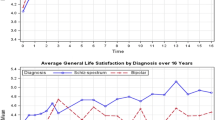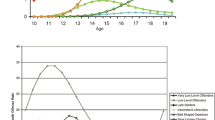Abstract
Investigators in mental health research are often interested in examining critical events such as onset, relapse, and recovery from illness, including substance use disorders. As data on these critical events are often collected at discrete-time intervals (e.g., weekly, monthly, or yearly), discrete-time survival models are more appropriate than well-known continuous-time methods. In this paper, we present discrete-time survival analysis methods at an introductory level. Using data collected every 6 months from a 3-year study of assertive community treatment in New Hampshire, we show that discrete-time survival models can be used to analyze patterns of remission from substance use disorder among clients with severe mental illness. The main questions investigated are (1) when are remissions more likely to occur? and (2) what variables predict remission? The results indicate that remission is more likely to occur in the first 6 months and in the 3rd year of the study. Gender, age, baseline use of substances, and diagnosis are strong predictors of remission.
Similar content being viewed by others
REFERENCES
Allison, P. (1982). Discrete-time methods for the analysis of event histories. In S. Leinhardt (Ed.), Sociological methodology 1982. San Francisco, CA: Jossey-Bass.
Allison, P. (1984). Event history analysis. Beverly Hills, CA: Sage.
Allison, P. (1995). Survival analysis using the SAS system: A practical guide. Gary, NC: SAS Institute.
Cox, D. R. (1972). Regression models and life tables. Journal of the Royal Statistical Society, Series B, 34, 187-202.
D'agostino, R., Lee, M., & Belanger, A. (1990). Relation of pooled logistic regression to time dependent Cox regression analysis: The Framingham Heart Study. Statistics in Medicine, 9, 1501-1515.
Drake, R. E., McHugo, G. J., Clark, R. E., Teague, G. B., Xie, H., Miles, K. et al. (1998). Assertive community treatment for patients with co-occurring severe mental illness and substance abuse disorder: A clinical trial. American Journal of Orthopsychiatry, 68(2), 201-215.
Drake, R. E., Mueser, K. T., & McHugo, G. J. (1996). Clinician rating scalse: Alcohol Use Scale (AUS), Drug Use Scale (DUS), and Substance Abuse Treatment Scale (SATS). In L. I. Sederer & B. Dickey (Eds.), Outcomes assessment in clinical practice (pp. 113-116). Baltimore, MD: Williams & Wilkins.
Han, A., & Hausman, J. (1990). Flexible parametric estimation of duration and competing risk model. Journal of Applied Econometrics, 5, 1-28.
Hedeker, D., Siddiqui, O., & Hu, F. (2000). Random-effects regression analysis of correlated grouped-time survival data. Statistical Methods in Medical Research, 9, 161-179.
Land, K., Nagin, D., & McCall, P. (2001). Discrete-time hazard regression models with hidden heterogeneity: The semiparametric mixed Poisson regression approach. Sociological Methods and Research, 29(3), 342-373.
McCullagh, P. (1980). Regression model for ordinal data (with discussion). Journal of the Royal Statistical Society, Series B, 42, 109-142.
McHugo, G. J., Drake, R. E., Burton, H. L., & Ackerson, T. M. (1995). A scale for assessing the stage of substance abuse treatment in persons with severe mental illness. Journal of Nervous and Mental Disease, 183, 762-767.
Peterson, T. (1991). The statistical analysis of event history. Sociological Methods and Research, 19(3), 270-323.
Scheike, T., & Jensen, T. (1997). A discrete survival model with random effects: An application to time to pregnancy. Biometrics, 53, 318-329.
Singer, J., & Willett, J. (1993). It's about time: Using discrete-time survival analysis to study duration and the timing of events. Journal of Educational Statistics, 18(2), 155-195.
Teachman, J. (1994). Marital status and the duration of joblessness among white men. Journal of Marriage and the Family, 56, 415-428.
Tuma, B., & Hanna, T. (1984). Social dynamics: Models and Methods. New York: Academic Press.
Willett, T., & Singer, J. (1991). From whether to when: New methods for studying student dropout and teacher attrition. Review of Educational Research, 61(4), 407-450.
Willett, J., & Singer, J. (1993). Investigating onset, cessation, relapse, and recovery: Why you should, and how you can, use discrete-time survival analysis to examine event occurrence. Journal of Consulting and Clinical Psychology, 61(6), 952-965.
Willett, J., Singer, J., & Martin, N. (1998). The design and analysis of longitudinal studies of development and psychopathology in context: Statistical models and methodological recommendations. Development and Psychopathology, 10, 395-426.
Author information
Authors and Affiliations
Rights and permissions
About this article
Cite this article
Xie, H., McHugo, G., Drake, R. et al. Using Discrete-Time Survival Analysis to Examine Patterns of Remission from Substance Use Disorder Among Persons with Severe Mental Illness. Ment Health Serv Res 5, 55–64 (2003). https://doi.org/10.1023/A:1021759509176
Issue Date:
DOI: https://doi.org/10.1023/A:1021759509176




